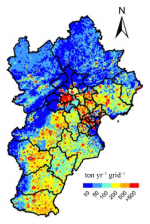摘要:
\textlessp\textgreater\textlessstrong\textgreaterAbstract.\textless/strong\textgreater Improving the accuracy of the anthropogenic volatile organic compound (VOC) emission inventory is essential for reducing air pollution. In this study, we established an emission inventory of anthropogenic VOCs in the Beijing–Tianjin–Hebei (BTH) region of China for 2015 based on the emission factor (EF) method. Online ambient VOC observations were conducted in one urban area of Beijing in January, April, July, and October, which, respectively, represented winter, spring, summer, and autumn in 2015. Furthermore, the developed emission inventory was evaluated by a comprehensive verification system based on the measurements and satellite retrieval results. Firstly, emissions of the individual species of the emission inventory were evaluated according to the ambient measurements and emission ratios versus carbon monoxide (CO). Secondly, the source structure of the emission inventory was evaluated using source appointment with the Positive Matrix Factorization (PMF) model. Thirdly, the spatial and temporal distribution of the developed emission inventory was evaluated by a satellite-derived emission inventory. According to the results of the emission inventory, the total anthropogenic VOC emissions in the BTH region were 3277.66 Gg in 2015. Online measurements showed that the average mixing ratio of VOCs in Beijing was approximately 49.94 ppbv in 2015, ranging from 10.67 to 245.54 ppbv. The annual emissions for 51 of 56 kinds of non-methane hydrocarbon species derived from the measurements agreed within \textlessspan class="inline-formula"\textgreater±100\textless/span\textgreater % with the results of the emission inventory. Based on the PMF results and the emission inventory, it is evident that vehicle-related emissions dominate the composition of anthropogenic VOCs in Beijing. The spatial correlation between the emission inventory and satellite inversion result was significant (\textlessspan class="inline-formula"\textgreater\textitp<0.01\textless/span\textgreater) with a correlation coefficient of 0.75. However, there were discrepancies between the relative contributions of fuel combustion, emissions of oxygenated VOCs (OVOCs), and halocarbons from the measurements and inventory. To obtain a more accurate emission inventory, we propose the investigation of the household coal consumption, the adjustment of EFs based on the latest pollution control policies, and the verification of the source profiles of OVOCs and halocarbons.\textless/p\textgreater
访问链接

